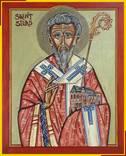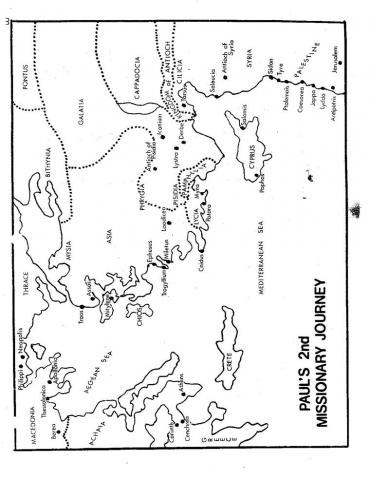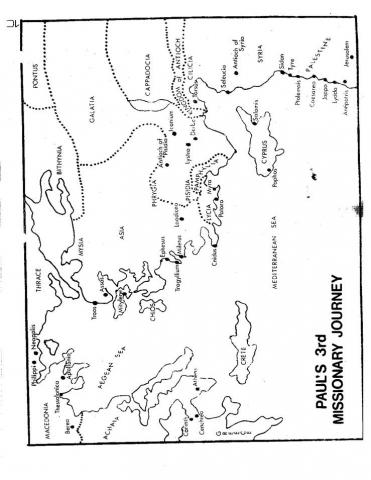St. Paul: 2nd and 3rd Journeys
PAUL AND HIS JOURNEYS: WEEK 2
Apostolic Synod in Jerusalem, 50 A.D. – review this from the last unit.
 Who was there?
Who was there?
What was decided?
Paul’s Second Missionary Journey, 53-55 A.D.: Again, have each student in about 5 minutes prepare one scene. Then follow the journey on your maps with the students telling the stories of each city.
1. The Journey itself:
A. Antioch, Barnabas and John Mark went to Cyprus: Acts 15:36-41
B. Cities in Asia Minor already visited, Timothy circumcised: Acts 16:1-4
C. Troas (Troy), dream of Macedonian man, Silas and Timothy: Acts 16:8-10
D. Neapolis: Acts 16:11
E. Philippi, Lydia, slave girl, earthquake and jailer: Acts 16:12-34 (break this up?)
F. Apollonia: Acts 17:1
G. Thessalonica, house of Jason, sent away by night: Acts 17:1-9
H. Berea: Acts 17:10-14
I. Athens, Mars Hill, Unknown God, Dionysius the Areopagite: Acts 17:15-23, 34
J. Corinth, Aquila and Priscilla (tentmakers): Acts 18:1-11
K. Ephesus, brief visit, left Aquila and Priscilla, Apollos: Acts 18:18-21
L. Caesarea in Palestine: Acts 18:22
M. Antioch: Acts 18:22
2. Places and their context:
Troas: Remember the story of Helen of Troy – well, this is Troy. Paris, prince of Troy,
stole Helen, wife of King Menelaus of Sparta, who tried for 10 years to get his
wife back. The Greeks took the city with a sneaky device known as the Trojan
Horse to this day. The Greek poet wrote the epic “Iliad” and “Odyssey” about
the Trojan War.
Philippi: The Church at Philippi became one of the most important established by St.
Paul. Luke himself, writer of the book of Acts, was left to take charge there. The
Church there continued to support Paul throughout his ministry. Paul’s Epistle to
the Philippians was written to this Church; can the students find this book of the
Bible?
Thessalonica: A well-traveled Roman road went from Philippi to Thessalonica. The
Epistles to the Thessalonians (1 & 2) were written to this Church. Can the
students find them?
Athens: Paul barely escaped Berea with his life. The Greek city of Athens is named for
the goddess Athena. It contains some of the most beautiful Greek architecture,
including the famous Parthenon on top of Acropolis hill. Show pictures if you
have any. The city was full of statues of a multitude of gods and goddesses. How
did Paul make Jesus known to the Athenians?
Corinth: If Athens was the capital of Greek education and culture, Corinth was a center of
shipping and trading. Here Paul made use of his childhood skill of tent-maker,
living and working with Priscilla and Aquila. The people of Corinth,
unfortunately, were known throughout the Empire for their sinful habits and poor
moral behavior. This would plague their early Church as well. Find the Epistles to
the Corinthians (1 & 2) in your Bibles.
Ephesus: This was the major city of Asia Minor. This was a brief visit; Paul would stay 2
years during his third missionary journey. Ephesus was a center for the worship of
Diana, goddess of the hunt. Here statues of Diana were a major source of income
for a large number of silversmiths. Would the silversmiths be pleased when
people became Christian? Find Paul’s Epistle to the Ephesians in the Bible.
Paul’s Third Missionary Journey, 56-59 A.D., Acts 18:23-19: Follow the same procedure as for the second journey.
1. The Journey itself:
A. Antioch: Acts 18:22-23
B. Ephesus, John’a baptism, silversmiths of Artemis: Acts 18:24-26, 19:11-12,
19:23-36
C. Macedonia and Greece, joined by Luke: Acts 20:1-3
D. Troas, Eutychus: Acts 20:6-12
E. Islands of Mitylene, Chios, Samos, Miletos, Cos. Rhodes, Patara: Acts 20:13-15,
21:1-2
F. Tyre: Acts 21:2-6
G. Caesarea of Palestine, Philip the Evangelist, Agabus: Acts 21:7-14
H. Jerusalem: Acts 21:15-19
- Places and their context (As Paul passes thru the cities studied in the first two journeys, mention them briefly and see how much the students remember about them):
Locate the myriad of islands on the west coast of Asia – how would Paul have traveled?
Tyre: Tyre and Sidon were the major cities of Phoenicia, known for their sailing and
trading. They made a world-famous purple dye called Tyrian purple. But, their
greatest accomplishment – our alphabet. If it weren’t for the Phoenicians, we
might be writing this in hieroglyphics!
Quiz Questions:
- Name at least 5 cities visited by St. Paul on his second missionary journey.
- Name at least 2 companions of St. Paul on his second and third missionary journeys. What happened to Barnabas and John Mark?
- Name at least 5 cities visited by St. Paul on his third missionary journey.
- Identify the following cities:
Home of Helen and Paris
Home of the Parthenon
Shipping center known for its immorality
Center for the worship of Artemis (Diana)
Leading city of Phoenicia

Primstav: Add St. Luke on October 18 and St. Aquila (with Priscilla) on July 14. Luke was a physician; perhaps the traditional physician symbol would be appropriate, the caduceus. What would work for the tent-makers, Aquila and Priscilla?
Close with Prayer.
